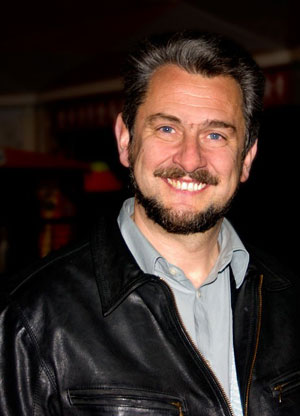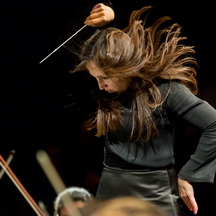Great black-and-white photographs have an integrity of texture that color would only obscure. In a program titled “Moving pictures, picture music,” the San Francisco Contemporary Music Players subsumed orchestral color for contrast, exploring a wealth of shades from ephemeral to nitty-gritty.
Alessandro Solbiati’s 2006 Sestetto à Gérard (Sextet for Gerard) played gossamer phantasms—ghost tones and muted strings—against the solidity of bass clarinet warmed by flute. Violinist Graeme Jennings held high tremolos, as violist Ellen Ruth Rose gave us slithers and scratchy double-stops. Cellist Leighton Fong rounded out the forest of whispers, made eerier by the odd tuning of each instrument: the three had their collective 12 strings retuned to the 12 steps of an octave, ensuring an even sense of randomness. A violin’s harmonious circle of fifths was squeezed into tritones, the viola tuned down its top strings, and the cello stretched both ends of its normal range to accommodate the music, theory trumping practicality.
And it must have been extraordinarily difficult to play, as string players fine-tune their finger positions by hearing the sound. If one plays a note, and the sound comes out a half-step higher, the feedback is confusing. And which note does one ink on the sheet? The actual note or the fingered one? Usually the latter, but it’s messy.
Furthering a “black-and-white” backdrop, Ann Yi played a piano that was also modified: some strings were deadened with bars and erasers into “dinks.” Resonant passages ran afoul of wooden thumps and clatter. Several in the audience looked around for the percussion blocks, perhaps hidden behind the piano.
As quick whispers slowed to longer bowing, Tod Brody traded bass flute for piccolo, and Peter Josheff followed with bright interjections and penetrating trills of a clarinet’s near tuning.
Bounced bows let the players retune as they played, and a slowly brightening bloom turned the last chords lovely.
Color returned for Philippe Hurel’s marimba solo, Loops IV, with Daniel Kennedy showing off flying fingers and tight control—his mallets were softened for a pianissimo that barely dented the air, then slowly swelled to bright and woody and as unlikely as a moose. Referencing the “looping” of electronic music, Hurel quotes and misquotes his material, confusing the listener’s conception of memory and prescience.
Julie Steinberg performed two solos for piano by Tristan Murail. Cloches d’adieu, et un sourire (Bells of farewell, and a smile) was a memorial to his teacher, Olivier Messiaen. Forceful attacks and a lone repeated note, the tolling of a death, gave way to high rapid figures, Messiaen’s beloved bird songs. La Mandragore followed, fluid but extreme. Steinberg imbued the phrases with dramatic presence and a spectral attention to vibration’s decay.
And then the show! A screen above the stage was lit with Jean Vigo’s surrealist silent film À propos de Nice. Composer François Paris set it for octet as one would set a poem. The music both stood alone and expanded the stark images, an absorbing look at class and poverty in Nice, France’s southern resort town. Paris’ delicious textures paralleled the black-and-white film, sly, herky-jerky, microtonal.
Vigo, who declined and died of tuberculosis after the filming, dehumanizes his subjects in service to social commentary, quick-cutting faces, laughter, legs. His absurdist approach is reinforced by a parade of huge papier-mâché puppets, from penguins to dancing girls to grotesque masks. The ending, a towering smokestack wreathed in smog, pays homage to industrial gods, with tremolo and the slow warbling of winds.
—Adam Broner
photo-Allesandro Solbiati
Originally published in the Piedmont Post
